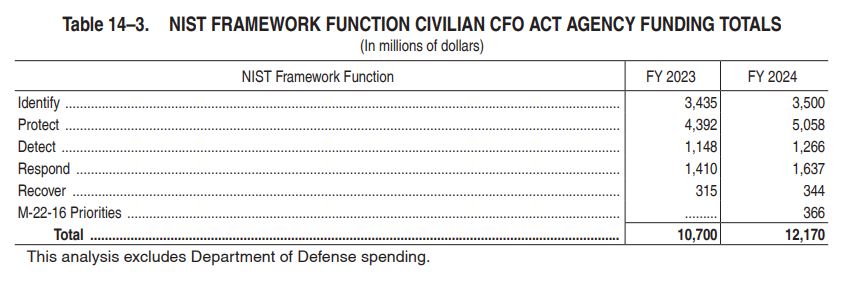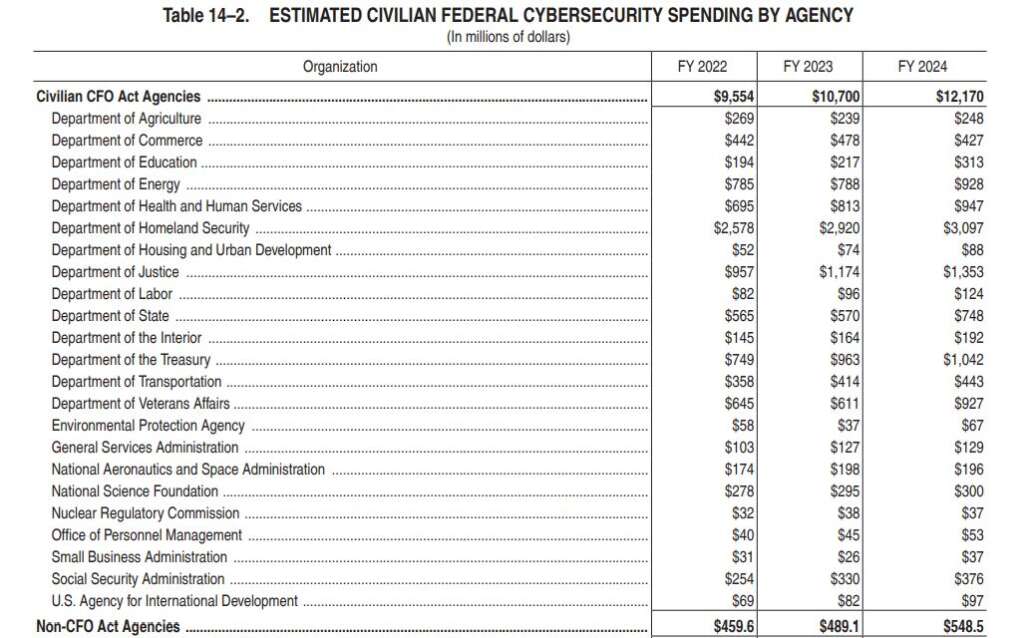Federal IT spending in 2024 request up by 13% in part thanks to cyber, CX plans
The White House plans to ask Congress for $ 74 billion in federal technology spending for civilian agencies in fiscal 2024. What is significant about that number isn’t the fact it’s a 13% increase over the 2023 request, rather it’s the specific detail the Office of Management and Budget lays out for what that increase will go toward.
The most obvious breakdown is in cybersecurity spending. The Biden administration wants to increase spending to secure federal networks, applications and data to $ 12.7 billion, a 13% increase over the prior year’s request. For the first time, OMB also offered new data on spending across three major priority areas outlined in the November 2022 memo: Improving the defense and resilience of government networks; Deepening cross-sector collaboration in defense of critical infrastructure; and Strengthening the foundations of our digitally-enabled future.

OMB released new details of the 2024 budget request sent to Congress on March 9.
The $ 366 million for cyber priorities along with the $ 12.1 billion being spent across all five pillars outlined by the National Institute of Standards and Technology is part of how the White House wants to further demonstrate the value of investing in cybersecurity.
Chris DeRusha, the federal chief information security officer, said during at the Zscaler Public Sector Summit on March 8, that by having the data it can help drive better conversations about investments and priorities.
“We’ve done data calls, mapping, tooling investments at agencies up into those pillars and actions, and capability areas. We can have all that data mapped out now, and give us one zero trust number for each agency. That’s exciting because now we can actually say we know how much money we’re spending on our priorities,” DeRusha said. “In the zero trust strategy, we took a lot of the stuff we’re trying to do in the cyber arena, we put it in there so that we will be able to track and measure the progress around it. And look, we know nothing’s perfect, but it is exciting to be able to have these vehicles to drive the change that you want to see.”
DeRusha said agencies now can answer questions about how their spending has changed year-over-year or what they are getting for those investments, something the government has struggled with previously.
Agencies will continue to collect and analyze their cyber spending and performance data as part of OMB’s oversight of their zero trust implementation.
DeRusha said every organization in the world struggles to answer the basic question of what they received for a specific cyber investment.
“What we’ve put together here is a model where we believe, over time, we’re going to really start to have an answer for that. Are these investments driving the change that we want to see?” he said in an interview with Federal News Network after his speech. “We’ll be able to know how much we invested here via the entire cyber budget, and it’s not just the top line number, which we’re sharing publicly, we have the data on the capability cones below it as well. To me that is exciting, because it’s a structure that can really, hopefully, inform good policy moving forward.”

The Biden administration also highlighted investments in customer experience.
OMB says, “the President’s 2024 budget includes more than $ 510 million to strengthen activities focused on modernizing programs, reducing administrative burdens, and piloting new online tools and technologies.”
While the White House offered some details about its CX investment plans in the “skinny budget” from March 9, the new data shows the administration wants to spend $ 13 million for six agencies to work directly with the General Services Administration’s Technology Transformation Services (TTS) for priority projects identified through CX action plans.
“Agencies and GSA can strategically deploy talent through teams such as the Digital Corps Fellows, Presidential Innovation Fellows, Centers of Excellence and 18F,” OMB stated in the budget. “For example, the Department of the Interior is provided $ 2.5 million to secure product management and develop talent to support efforts such as the Fish and Wildlife Services’ digital permitting activities, and online management of Individual Indian Money accounts.”
The administration also rolled up funding, totaling $ 75 million, for interagency life experience work “to enable more efficient administration of federally-funded benefits programs, improve the journey of disaster survivors accessing federal assistance, and streamline the Medicare enrollment process for seniors. At least 10 federal agencies will play a role in implementing these multi-agency projects.”
Additionally, the White House is funding what they called the “development of enterprise Voice of Customer platforms at seven federal agencies, building on the existing efforts of individual high impact service providers. Further investment in enterprise Voice of Customer platforms will allow federal agencies to develop the in-house capacity to engage customers at the point of service, reaching a broad range of community voices so that agencies may consider a variety of customer perspectives and experiences in developing their customer experience strategies. For example, the Office of Federal Student Aid will leverage more robust Voice of Customer tools to better understand the needs of students, parents, and borrowers across the phases of loan management, from application through to repayment.”
These two examples of how the administration is delineating its spending plans coincide with a significant increase in federal civilian IT spending as well as increases in other governmentwide IT modernizations.
Of the 25 CFO Act agencies, 19 would see IT budget increases in 2024, including the departments of Veterans Affairs ($ 2.3 billion increase as compared to the 2023 request), Health and Human Services ($ 2.2 billion) and Treasury ($ 1.5 billion) and the Environmental Protection Agency ($ 91 million) and Small Business Administration ($ 150 million) among the potential winners.

“The budget supports launching tech policy that meets today’s expectations and technology that is secure by design, allowing federal agencies to deliver on their missions safely, reliably, and easily,” the budget stated. “The administration is focused on understanding where agencies are on their IT modernization journeys and making the right investments at the right time to enable secure technology and innovation to advance from year to year.”
In addition to individual agency IT budgets, the Biden administration is requesting $ 200 million for the Technology Modernization Fund, down from $ 300 million in 2023; $ 90 million for the Federal Citizen Services Fund run by the General Services Administration; and $ 14 million for OMB’s IT Oversight and Reform (ITOR) fund.
Congress appropriated $ 90 million for the citizen services fund and $ 14 million for ITOR in 2023.
Along with the $ 200 million request for the TMF, GSA, which received $ 50 million in 2023 from Congress, estimated it would have $ 401 million in unobligated funds in 2024, down from $ 879 million in 2023.
